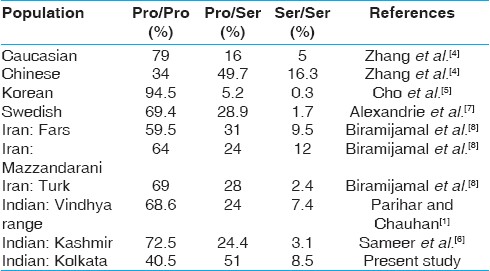|
 
 |
|
LETTER TO THE EDITOR |
|
|
|
| Year : 2011 | Volume
: 17
| Issue : 3 | Page : 244-245 |
| |
NQO1 C 609 T polymorphisms analyzed in a population from Kolkata, West Bengal
Sanjit Mukherjee, Keya Chaudhuri
Molecular and Human Genetics Division, Indian Institute of Chemical Biology (A Unit of CSIR), Kolkata - 700 032, India
| Date of Web Publication | 20-Jan-2012 |
Correspondence Address:
Keya Chaudhuri
Molecular and Human Genetics Division, Indian Institute of Chemical Biology (A Unit of CSIR), 4 Raja S C Mullick Road, Kolkata - 700 032
India
 Source of Support: None, Conflict of Interest: None
DOI: 10.4103/0971-6866.92083

How to cite this article:
Mukherjee S, Chaudhuri K. NQO1 C 609 T polymorphisms analyzed in a population from Kolkata, West Bengal. Indian J Hum Genet 2011;17:244-5 |
How to cite this URL:
Mukherjee S, Chaudhuri K. NQO1 C 609 T polymorphisms analyzed in a population from Kolkata, West Bengal. Indian J Hum Genet [serial online] 2011 [cited 2016 May 13];17:244-5. Available from: http://www.ijhg.com/text.asp?2011/17/3/244/92083 |
Sir,
The recent paper of Parihar and Chauhan [1] in your journal showed that the frequencies of different polymorphs of NQO1 genes were statistically distinct in the population residing in Vindhyan range, Madhya Pradesh, India, compared with the Caucasian and other Asian and European populations.
NADP (H) Quinone Oxidoreductase 1 participates in detoxification of numerous compounds mainly by catalyzing the 2 electron reduction of the quinones to hydroquinones. Its polymorphic variant, C 609 T, is gaining much importance as it has a direct effect on the catalytic potential of the enzyme. The NQO1 variant form C 609 T, which leads to an amino acid change from Proline to Serine at codon position 187, exposes the enzyme to proteosomal degradation so that the available protein is less, and this leads to accumulation of Reactive Oxygen Species (ROS). The heterozygous carrier of this variant form has a 60% less catalytic efficiency, whereas a negligible amount of enzyme is found in homozygous mutant variant individuals, making the individuals more susceptible to carcinogenesis. This variant form of NQO1 is shown to be associated with an increased risk of acute myeloblastic leukemia [2] and many tobacco-associated cancers, namely lung cancer, colorectal cancer, [3] esophageal cancer [4] and, mostly, head and squamous cell carcinomas, [5] in many parts of the world.
The use of tobacco and its associated products, either smoking or smokeless forms, or chewing arecanut as "pan masala" or "gutkha" is highly prevalent in south-east Asia, especially in the Indian subcontinent. Therefore, it is important to study the genetic predisposition of NQO1 polymorphism across various regions of the Indian subcontinent. Again, ethnicity is one of the main factors to be considered in genetic predisposition. However, very few studies exist depicting the prevalence of this NQO1 C 609 T genotype in the Indian subcontinent. [1],[6]
In this context, our pilot study examined the prevalence of NQO1 C 609 T polymorphism among 152 individuals from Kolkata, West Bengal [Table 1] in a different region of India compared with earlier studies. In our study, 78 (51.0%) individuals were found to carry minor T as heterozygous state whereas 13 (8.5%) individuals were homozygous mutants for this polymorphism. When stratified according to sex, both heterozygous and homozygous was found to be equally distributed [Table 1]. | Table 1: Distribution of NQO1 genotypes among the study groups of Kolkata, West Bengal population
Click here to view |
Interestingly, comparison of our results with the genotype frequencies observed in Caucasian, Chinese, Korean, Swedish, Iranian and Indian populations revealed that the population of this region of eastern India is distinct with respect to all other population except the Chinese, to which it bears close resemblance [Table 2]. | Table 2: Distribution of NQO1 genotypes among the study groups of different Asian and European populations
Click here to view |
Moreover, the frequencies of TT and CT genotypes are higher in this population compared with those from other parts of India. Further studies need to be focused on the correlation of NQO1 genotypes with smoking/chewing habits, and the association with oral cancer and precancer would predict the risk of carcinogenesis in this population. [8]
 References References | |  |
| 1. | Parihar SS, Chauhan UK. The NQO1 allelic frequency in hindu population of central India varies from that of other Asian populations. Indian J Hum Genet 2010;16:133-7. 
[PUBMED]  |
| 2. | Guha N, Chang JS, Chokkalingam AP, Wiemels JL, Smith MT, Buffler PA. NQO1 polymorphisms and de novo childhood leukemia: a Huge review and meta-analysis. Am J Epidemiol 2008;168:1221-32. 
[PUBMED] [FULLTEXT] |
| 3. | Chao C, Zhang ZF, Berthiller J, Boffetta P, Hashibe M. NAD(P)H:Quinone Oxidoreductase 1 (NQO1) Pro187Ser Polymorphism and the Risk of Lung, Bladder, and Colorectal Cancers: a Meta-analysis. Cancer Epidemiol Biomarkers Prev 2006;15:979-87. 
[PUBMED] [FULLTEXT] |
| 4. | Zhang JH, Li Y, Wang R, Geddert H, Guo W, Wen DG, et al. NQO1 C609T polymorphism associated with esophageal cancer and gastric cardiac carcinoma in North China. World J Gastroenterol 2003;9:1390-3. 
[PUBMED] [FULLTEXT] |
| 5. | Cho CG, Lee SK, Nam S, Lee M, Lee S, Choi EK, et al. Association of the GSTP1 and NQO1 Polymorphisms and Head and Neck Squamous Cell Carcinoma Risk. J Korean Med Sci 2006;21:1075-9. 
|
| 6. | Sameer AS, Shah ZA, Syeed N, Abdullah S, Rasool R, Afroze D, et al. NAD(P)H:quinone oxidoreductase 1 (NQO1) Pro187Ser Polymorphism and Colorectal cancer predisposition in the ethnic Kashmiri population. Asian Pac J Cancer Prev 2010;11:209-13. 
|
| 7. | Alexandrie A, Nyberg F, Warholm M, Rannug A. Influence of CYP1A1, GSTM1, GSTT1, and NQO1 genotypesand cumulative smoking dose on lung cancer risk in a Swedish population. Cancer Epidemiol Biomarkers Prev 2004;13:908-14. 
|
| 8. | Biramijamal F, Hossein M, Mohammed S, Banoei M, Bayat B, Arjmand S, et al. Genetic polymorphism analysis of NAD(P)H: Quinone oxidoreductase 1 in different Iranian ethnic groups. Curr Sci 2006;91:1065-8. 
|
[Table 1], [Table 2]
|






